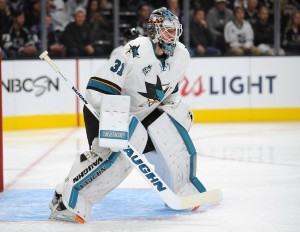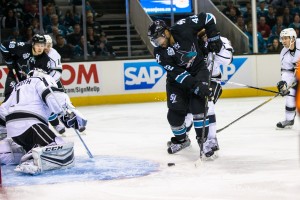In the second part of our contract analysis series for the San Jose Sharks, we’ll take a more extensive look at three of the more interesting deals, those for Martin Jones, Joel Ward and Paul Martin. The first piece in the series gave out contract grades and is linked here.
I’ll start by discussing an emerging issue: the potential for an NHL expansion after next season. Should the league choose expansion, it means each team will have the opportunity to protect players, but they will also need to leave several players open to an expansion draft. According to reports, the league will require sort of a reverse salary cap. Each team must have unprotected players whose pay adds up to 25% of the salary cap. This would push more good players into the expansion draft pool. It is easy to forecast how the Sharks will handle these three players. Goalie Martin Jones will be protected, while defenseman Paul Martin and forward Joel Ward will not.
Martin Jones
Goalie Martin Jones’ contract received an ‘A’ grade in the prior article. Jones is in the first year of a three-year deal, which pays him $3 million per season. Sharks general manager Doug Wilson took a risk on Jones, a goalie with less than half a season’s worth of NHL games. He also gave up the rights to a prospect and a first round pick. Shortly after the trade, Wilson inked Jones to his current deal. Jones has been good, not great. But he does show the potential to be a top-10 goalie.
This season, his workload has exceeded what the Sharks anticipated. Backup goalie Alex Stalock had a miserable season, forcing the Sharks to start Jones for lengthy stretches with minimal breaks. A late-season trade for James Reimer has taken some of the load off Jones.

Jones sits in the middle of the pack in terms of save percentage at .919. He sits near the top in wins (third) and shutouts (tied for fourth). A 4-2 loss (one empty-net goal) this past weekend broke a string of 10 games where Jones had allowed two goals or less. In January, Jones posted a .923 save percentage; it was .922 in February and .932 thus far in March. At 26-years old, he appears destined to improve as he enters his prime.
The goalie is good, the contract is exceptional. In the prior article, I noted that Jones is 29th amongst NHL goalies in cap hit. In a 30-team league, only the Sabres, Oilers, Blues and Ducks spend less on their top-paid goalies this season.
Four goalies make $7 million per season or more. Another dozen fit between $5.5-$7.0 million. These two groups contain half the league’s starters, including most of the league’s better goalies. They average more than double what Jones earns. There are 25 goalies who make in excess of $4 million per season, all at least $1 million more than Jones.
Jones will have a chance at a much larger payday in a couple of years. For now, he is among the league’s best bargains. The average cap hit for the other goalies in the league’s top 10 in wins is a tad over $6 million and only one (Devan Dubnyk) is below $5 million. Jones is in good company with his play, but his contract stands among the best goalie bargains in hockey.
Paul Martin and Joel Ward
In first part of the series, Martin’s contract merited a ‘B’ grade while Ward’s contract merited a ‘C.’ The contracts for the two players will be analyzed together because they have some key similarities. They were both signed as free agents this past offseason (signing higher end free agents is a rarity for the Sharks). Both are the same age (35) and entering the point in a career where one might expect to see a drop off in play. Both came with extensive playoff experience and have played with elite players. Neither came with Cup Finals experience.
http://gty.im/516904244
Both are signed to deals that would place them on the Sharks during an NHL expansion draft, should it take place in the 2017 offseason. Neither player is likely to be protected in an expansion draft. If the reports hold true and teams are required to meet a minimum salary figure for the unprotected players, Ward and Martin will make up a very sizeable part of that amount for San Jose (about $8 million out of a required $18-20 million). In that sense, their deals provide added value should an expansion draft occur. They will help the Sharks reach their minimum figure requirement for an expansion draft. An expansion team is unlikely to take on a 37-year old. If they did, it would create cap space for the Sharks to acquire a replacement. Unlikely does not mean impossible. An expansion team might want a veteran presence. The Sharks own history points to this possibility. For their first season, they acquired 34-year-old defenseman Doug Wilson. Wilson served as the team’s first captain. A quarter century later, he is the Sharks’ general manager.
If based solely on this season, Martin’s contract might merit a higher grade than a ‘B.’ Martin was brought to San Jose for one main reason: to help fix Brent Burns as a defenseman. After an uneven first half of the season, it is now mission accomplished. Martin, in his own quiet and steady manner, has climbed to a plus-15, tied for fourth best on the team. Not an easy task to be that positive, given his primary partner, Burns, was once as low as minus-15 on the season. Martin has 18 even-strength points; he has only reached 20 twice in his career. He is on track to play the most games he’s played in one season since he was 26.
Martin’s deal takes him to age 38 and he isn’t cheap at a bit under $5 million per season. The odds are against him being a good value for the entire deal (examples of current defensemen whose play dropped after 35 include Dan Boyle, Andrew Ference, Dennis Seidenberg and Rob Scuderi). Martin is a good value now, which should make up for diminished value later in the deal.

Martin’s success is contrasted with Ward, whose contract received a ‘C’ grade. Ward’s deal runs for three years, at just under $3.3 million per season. Unlike Martin, Ward peaked in the first two months of the season, when he put up 20 points in 24 games. His productivity has declined since. Ward’s early contributions were important for helping the team through some rough patches. However, for much of the season, he’s been relatively quiet and only modestly effective. There is a good chance this is a harbinger of things to come on a deal that runs two more seasons.
Ward is a tad under 50 percent in the face-off circle. He is third among Sharks forwards in penalty-kill time-on-ice, but poorest in goals allowed per 60 minutes of penalty-kill ice time, the only Shark over 10.0 in that metric.
While Martin helped his primary partner, Ward has been unable to slow the decline of his. At even strength, Ward has played roughly 80 percent of his minutes with Patrick Marleau; both are among the worst on the team in plus/minus. Ward now sits at minus-14, easily a career worst. There are important indications which suggest the tank is far from empty. He will likely finish the regular season with his second highest single season totals in goals, assists and points. His total time-on-ice is likely to come close to his career high as well.
In prior NHL stops, Ward has been shuffled up and down the lineup. Though mostly used on second and third lines, he has played on top lines and not looked out of place. He has upside if he can find linemates that are able to take better advantage of his current skill set.
Ward’s deal has the benefit of being modest enough and short enough that the downside is not a major issue. As for upside, Ward has proven valuable during the playoffs, including a Game 7 overtime winner while a member of the Capitals.
Zeke’s Notes
Joel Ward is a likable as it gets. Ward had a stop in Houston on his journey to the NHL. When I asked friends from Houston about him, they called him “an awesome guy.”
After covering contracts in this article that graded out to an A, a B and a C, I’ll cover the lone deal that garnered a D grade in the next part.
For Sharks fans who just knew the league office has a bias against the team, well, you’ve got your proof. A series of released e-mails is proving embarrassing to the league. It includes NHL senior executive Colin Campbell referring to the Sharks GM as “Doug Whine Wilson” among other less-than-professional references. The e-mails coming out are related to the concussion issues with the league and this is a far bigger story than a culture of pettiness in the league office. But this pettiness isn’t going to help the league. I’ll put this in the category of collateral damage. The league has never had much credibility on concussions, something they will pay for down the road in a massive way. These e-mails, and there will almost certainly be many more to come, have broadened the credibility problems of NHL management.